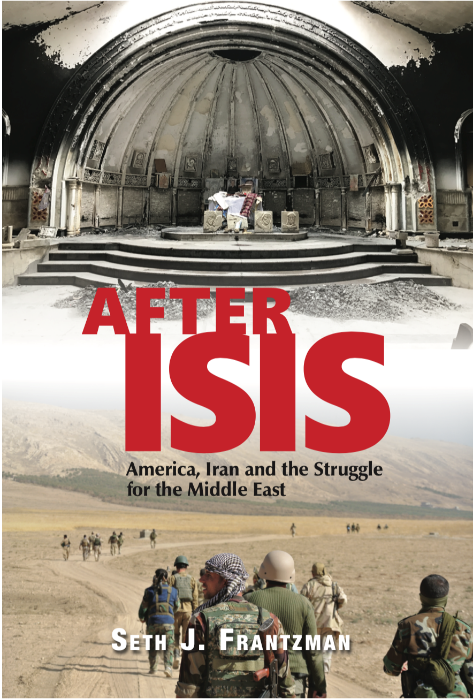BESA Center Perspectives Paper No. 1,375, December 18, 2019
EXECUTIVE SUMMARY: October 27, 2019 marked the death of infamous “Caliph” Abu Bakr al-Baghdadi. Once his demise had been confirmed, optimistic media voices asserted that the last chapter of the Islamic State of Iraq and Syria (ISIS) had been written. The western world very much wants to believe we are living in a new, post-ISIS era. But are we?
Several months before the death of Islamist madman Abu Bakr al-Baghdadi, Israeli journalist and scholar Seth Frantzman published his tour de force volume, After ISIS: America, Iran and the Struggle for the Middle East—a thought-provoking and at times heartbreaking narration of a war and its ongoing aftermath.
Does Frantzman believe we are living in an “after ISIS” world? Not exactly.
His book provides a painstakingly researched and carefully documented overview of a modern war. It includes the author’s personal accounts of explosive battle scenes, half-buried mass graves, and hungry, homeless children—scenes he witnessed while deployed with Kurdish Peshmerga fighters.
Here, for example, he describes what he saw in the aftermath of the Yazidi slaughter:
Here in the killing fields of Sinjar, the bones of those killed in 2014 sit on the surface. Human hair pokes through grass that has grown on the bodies. Skull fragments. Bullet casings… A teenager’s soccer jersey that says “Emirates” on it. The clothes people wore when they were murdered are there. The blindfolds they wore could be seen.
The author’s narrative reflects his personal response—anger—and not only at the barbaric killing of untold thousands of Yazidis, Christians, Kurds, and Arabs. He is also angered by the lack of international investigation, or of NGO assistance to the desperate survivors. How could the Western powers, he asks, “with all their technology, all their drones, their EU Parliament and councils of human rights and international criminal courts, do nothing?”
Frantzman provides a sketch of Iraq’s military capabilities (or lack thereof) and includes perspectives of American military officers, some of whom fought in Iraq against Saddam Hussein in 2003-04.
After the 2006 supposed demise of al-Qaeda and the Islamic State of Iraq thanks to the killing of its leader Abu Musab Zarqawi, radicalized foreign fighters made their first major appearance in Iraq. In response, the US deployed more soldiers and increased its assaults.
The Americans’ provision of military equipment was enormous. At the November 2007 peak, US military forces in Iraq numbered 170,300.
President Barack Obama ordered US troops out of Iraq in December 2007. Their withdrawal was completed by December 2011, supposedly bringing an end to the Iraq War.
Unfortunately, much of the US military equipment that had been provided to the Iraqi Army fell into the hands of ISIS following their stunning 2014 declaration of the “Caliphate” and subsequent ruinous march across Iraq’s heartland.
In the meantime, as the US and its allies began to fight in earnest against ISIS, the terrorist group was expanding rapidly beyond the Middle East. Frantzman writes,
The war in Iraq and Syria and the slow mission-creep taking place was also expanding into Yemen, Somalia, Africa, Asia. Much of this was a war against terrorism…ISIS was making inroads in Asia and had recruiting tentacles throughout the world, from Bangladesh to Indonesia and the Caribbean.
Detailing the rapidly expanding “Caliphate” in the Middle East, After ISIS focuses on other areas of concern such as Turkey, Senegal, and Europe, as ripples of both refugees and terror threats reached high-tide levels across seas and border crossings.
At the time of this writing, the Middle East is roiled by weeks of angry street demonstrations. Protesters in Iran are challenging the ayatollahs’ despotic rule, chanting in outrage against the regime’s aggressive and costly power plays in Iraq, Syria, Lebanon, Yemen, and the Palestinian-controlled territories.
Turkey continues its brutal invasion of northern Syria, slaughtering hundreds of non-combatants whom they brand “terrorists” and displacing hundreds of thousands of Kurds, Yazidis, Christians, and Arabs. Turkish President Recep Tayyip Erdoğan has acted with impunity in this radical ethnic cleansing project, for which he appears to have the blessing of President Donald Trump.
In his conclusion, Frantzman offers several possible scenarios regarding ISIS, Iran, Iraq, and other states. His forecast on ISIS appears to be unfolding already: that inside crippled Syria, the group will form new sleeper cells and a coalition of like-minded fighters.
He writes that the US-led coalition
is left with another complex choice. Stay in Syria to fight while Russia, Iran and Turkey oppose the coalition’s presence or leave and let Russia, Iran and Turkey fight ISIS. Leaving behind instability leads to ISIS renewing its presence in formerly cleared areas and to fueling a cycle of instability in Iraq and Syria along their common border.
Meanwhile, ISIS grows in strength in the Sahel and Afghanistan and puts down roots in other countries in Asia. It continues to be a global threat, but the US tendency to reduce America’s role in countries throughout the world leaves those countries attempting to fill the gap in American power with local policies than cannot defeat ISIS globally.
For years, news about the war against ISIS has come out in bits and pieces. It has been difficult to follow and lacking in context and perspective. Frantzman not only embedded himself repeatedly with Kurdish Peshmerga fighters but applied historical and political analysis to the seemingly endless fighting. After ISIS is an important contribution to a complex discourse.
Lela Gilbert is the author of Saturday People, Sunday People: Israel through the Eyes of a Christian Sojourner (Encounter Books, 2012) as well as many other books. At the Hudson Institute, she co-edits the publication Current Trends in Islamist Ideology.


